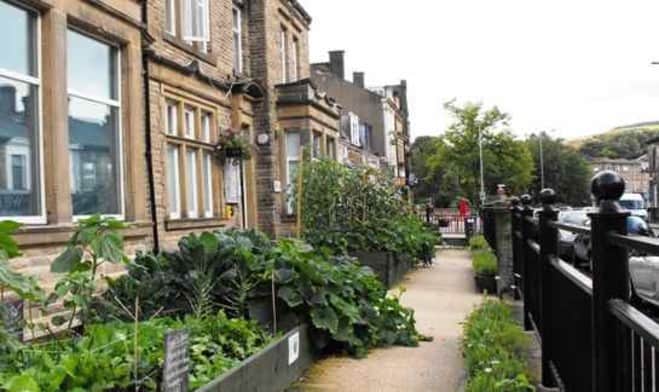A few years ago, Pam Warhurst and a small group of community members in Todmorden, England, sat down at her kitchen table to answer one question: “Can we find a unifying language that cuts across age, income and culture that will help people themselves find a new way of living, see spaces differently, think about the resources they use differently, and interact differently?” Remarkably, that group found the answer to that question of how to engage community members in sustainable community development. That language is food.
Todmorden is a town of 50,000 people nestled in the hills of central England. While at first glance, the town looks ordinary; it is actually the starting point for a social movement based around food. Garden plots dot the downtown streets. Corn stalks stretch tall in front of the police station. Even cemeteries host raised beds full of collard greens and cabbage. Everyone in the community seems to boast their gardening abilities in every square inch of workable soil. How can a community make such a sweeping change over a few-year period?
The concept is surprisingly simple. The movement did not need to attain incredible amounts of start-up money or jump through bureaucratic hoops to acquire permits or meet regulatory standards. Warhurst posits that all one really needs is the gumption to make things happen and the willingness to collaborate. Incredible Edible began as a seed swap and grew into an urban garden utopia all due to collaborative efforts of motivated community members.
The Incredible Edible concept is based on a three-plate model of society: community, education and business. By having all of these plates “spin” together around food, food will inevitably become a part of all aspects of society. Warhurst held a public meeting to illustrate her concept, and, even without extensive predictive reports or models, the community members sincerely supported her ideas. After the meeting, volunteers from the Incredible Edible team set out to build relationships with business owners, educators, local government officials and community members. The downtown area quickly turned into an edible mecca and the Incredible Edible Green Route began. Vegetable tourism took over Todmorden. People from all over the globe came to walk the streets and tour the gardens. Warhurst calls it propaganda gardening: the more public the gardening, the more people want to participate.
Warhurst did not stop with the Green Route. Incredible Edible partnered with a local high school to create an aquaponics system and orchard for students to participate in growing fish, fruit and vegetables. The project had such success that faculty from the school added agriculture to the curriculum and acquired a plot of land to use as market garden training center. Incredible Edible also put a brand to their name so that locally sourced products in stores could easily be recognized. Additionally, all of the egg producers were mapped out in Warhurst’s Every Egg Matters project. The result: 49 percent of the stores that traded Incredible Edible food saw an increase in profits. Farmers and businesses alike reaped the benefits of Incredible Edible.
All of Warhurst’s efforts were incredibly simple steps that any community can take. For guidance, a variety of instructional forms can be found on the Incredible Edible website. Now, over 30 towns in England boast switching to the Incredible Edible model. Even other countries have caught on to Warhurst’s concept. As she says, “We are all part of the local food jigsaw. We are all part of a solution.”













